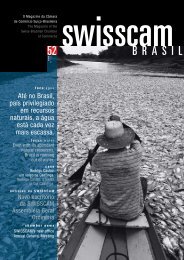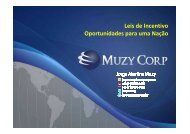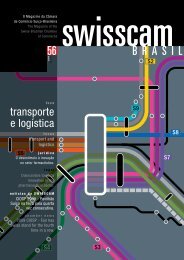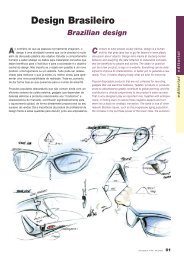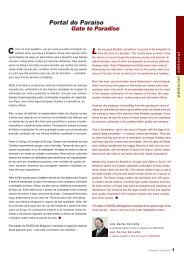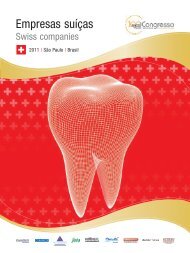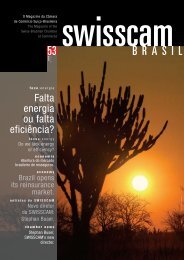01 Logística e Infra-estrutura no Brasil – Desafios e ... - Swisscam
01 Logística e Infra-estrutura no Brasil – Desafios e ... - Swisscam
01 Logística e Infra-estrutura no Brasil – Desafios e ... - Swisscam
Create successful ePaper yourself
Turn your PDF publications into a flip-book with our unique Google optimized e-Paper software.
eco<strong>no</strong>mia brasileira<br />
Brazilian eco<strong>no</strong>my<br />
needs a boost<br />
Thanks to the responsible eco<strong>no</strong>mic<br />
policy maintained in 2005, the Brazilian<br />
eco<strong>no</strong>my stands on a reasonably solid<br />
basis. However, expectations for 2006<br />
are <strong>no</strong>t so rosy. The country needs a<br />
boost to prevent bureaucracy, the heavy<br />
tax load, protectionism and the exorbitant<br />
interest rates from hindering eco<strong>no</strong>mic<br />
growth<br />
Foto: Ulisses Matandos<br />
brazilian eco<strong>no</strong>my<br />
Few promises for 2006<br />
by Christiane Henkel<br />
Brazilian president, Luiz Inácio Lula da Silva,<br />
was a little too audacious in his forecast for<br />
2006. He said the Brazilian eco<strong>no</strong>my would<br />
grow as much as in 2004, reaching around<br />
5%. He added that was <strong>no</strong>t a forecast; it<br />
was a guarantee. Actually, such significant<br />
growth would be theoretically possible. The<br />
eco<strong>no</strong>mic growth potential, that is, growth<br />
that can be achieved using the country’s<br />
existing capacity, is at most 5%.<br />
Chain of favorable conditions<br />
However, it is <strong>no</strong>t realistic to speculate that<br />
the country’s GDP will grow as much as in<br />
2004. That year, Brazil was blessed by a<br />
series of favorable circumstances: the weak<br />
Real and the strong foreign demand for raw<br />
materials and agricultural products stimulated<br />
exports, climatic conditions allowed for<br />
record harvests, and, because the country<br />
was on the verge of a recession in 2003<br />
(GDP +0,5%), the statistics ended up overvaluing<br />
the growth rate.<br />
In 2005, however, the tenth largest eco<strong>no</strong>my<br />
in the world grew below the expectations. In<br />
its recent inflation report, the Brazilian Central<br />
Bank changed its 3.4% projection to 2.6%.<br />
The agricultural sector was hurt by climatic<br />
and sanitary problems; the industrial sector<br />
and exports slowed down because of the<br />
high interest rates and the appreciated Real.<br />
The UN Eco<strong>no</strong>mic Commission for Latin<br />
America (ECLAC) estimates the Brazilian<br />
eco<strong>no</strong>my will grow only 2.5%. In that case,<br />
the country’s growth rate would be far below<br />
the region’s average rate of 4.3%. However,<br />
a strong growth in a country in Latin<br />
America is <strong>no</strong>t necessarily a decisive factor<br />
to determine how solid its eco<strong>no</strong>my is. Let us<br />
consider the countries ranking at the top of<br />
the Eclac’s list: Venezuela (9%) and Argentina<br />
(8.6%), countries whose eco<strong>no</strong>mies are<br />
increasingly unstable and whose growth<br />
rates are unsustainable.<br />
Sustainability over short-term<br />
success<br />
Brazil is going the opposite way: it is cementing<br />
its eco<strong>no</strong>mic foundation, without<br />
prioritizing growth. Brazilian growth rates<br />
are timid because, among other reasons,<br />
the country is working towards achieving<br />
sustainable growth and assuring a stable<br />
macroeco<strong>no</strong>mic structure. The government’s<br />
central-left coalition is conducting its strict<br />
eco<strong>no</strong>mic policy. The priority in 2005 was<br />
to assure continuing low inflation rates by<br />
keeping interest rates high: Brazilian real<br />
Brazil has taken a historic<br />
turn in record time, turning<br />
from an eco<strong>no</strong>my focused on<br />
the domestic market into an<br />
exporting eco<strong>no</strong>my<br />
interest rates are among the highest in the<br />
world. However, the effort has paid off: for<br />
the first time in many years, the Brazilian<br />
Central Bank has lowered inflation to the<br />
pre-established level.<br />
The eco<strong>no</strong>mic strategy in 2005 also succeeded<br />
in lowering the country’s foreign<br />
debt. The country will probably achieve a<br />
primary surplus (before payment of interest<br />
rates) of 4.8% of the GDP, or R$ 95 billion,<br />
this way surpassing the 4.5% target. Unfortunately,<br />
<strong>no</strong>t everything is rosy: achieving<br />
these results was only possible through<br />
reducing investment and raising taxes. Even<br />
so, they are extremely important, since they<br />
allow the country to pay the biggest portion<br />
of its foreign debt interests without borrowing<br />
new money. Consequently, new indebtedness<br />
is low and, thanks to the eco<strong>no</strong>mic<br />
growth, public debt, as a percentage of the<br />
GDP, is even decreasing.<br />
The government’s efforts in the composition<br />
of public debt are also an attempt to lower<br />
the level of indebtedness. A team of expert<br />
tech<strong>no</strong>crats of the Ministry of Eco<strong>no</strong>my<br />
have succeeded in partially consolidating<br />
the previously unstable “debt mountain”.<br />
Above all, the country is <strong>no</strong>t so dependent<br />
on exchange rate fluctuations anymore.<br />
Today, only about 3% of all government<br />
bonds are directly linked to the dollar-real<br />
variation; in October 20<strong>01</strong>, the percentage<br />
was 33%. This means drastic exchange rate<br />
variations, which punished Brazil in the past,<br />
will <strong>no</strong>t have such high impact on the<br />
country’s level of indebtedness any more.<br />
Long-term growth consolidation<br />
The government continues its efforts towards<br />
stabilization, initiated in 1994 with the<br />
monetary reform, and has succeeded in<br />
securing what has been achieved so far.<br />
Simultaneously, Brazil has taken a historic<br />
turn in record time, turning from an<br />
eco<strong>no</strong>my focused on the domestic market<br />
into an exporting eco<strong>no</strong>my. The volume of<br />
exports is expected to increase two-fold<br />
compared to three years ago, and reach<br />
04 swisscam nº44 03/2006



